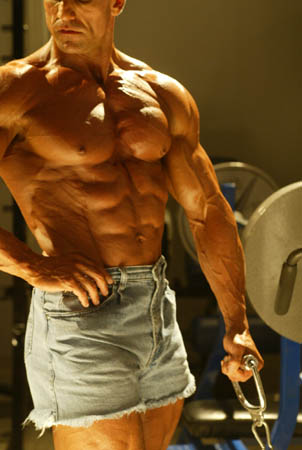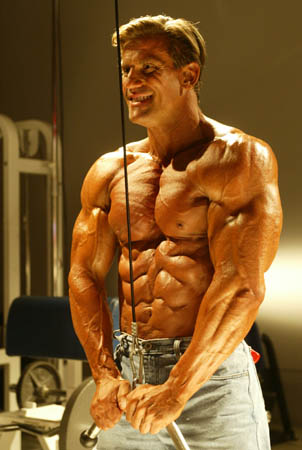|
Recuperation:
TRAIN HARD! REST HARD!
The experts state that,
"Muscles take at least 72 hours to fully recuperate."
This might be true, but I still would not recommend constructing
a workout routine based solely on this statement. I would guess
that it takes longer than 72 hours to GROW MUSCLES! And I will bet
that it takes your nervous system and glands longer than 72 hours
to recover from a hard squat or back workout. The lesson to be learned
here is to not follow an arbitrary amount of hours determined by
"science" between your workouts. The guidelines help:
light weights impose less stress than heavy weights, arms less stress
than legs, and so on, but in the end you will have to judge for
yourself if YOU ARE RECOVERED enough to return to the gym. You must
balance your hard work in the gym with enough rest time to GROW
from the hard training. Rotating bodyparts, in itself, does not
provide enough rest. You have to take days of complete rest between
HARD workouts to fully recuperate and grow. You MUST rest your entire
body.
With recovery there are
many variables to consider. The bottom line is if you train hard
you have to rest hard. You will find that certain exercises require
near maximum intensity to perform the workout, and require several
days of complete rest to recover properly from (like heavy deadlifts).
The rule of thumb is to wait until you feel recovered before going
back to the gym. Quite often a heavy workout is followed by a two
or more-day rest period.
Modern bodybuilding has
been saturated with the BODY PART SPLIT SYSTEM. Day One is Legs,
Day Two is back, Day Three is Arms, and so on. This splitting is
not the best way to train for maximum strength and size. Your
body, as a system, needs days of rest. You don't need 22 sets for
back and 18 sets for chest, and so on..with all sorts of multiangle
exercises to make progress. In fact just the opposite is true.
You need 6 to 8 basic,
hard exercises, done in good form, performed every few days, for
15 to 20 some total sets. Some of you may not believe this type
of training works. I challenge you to prove me wrong. Train this
way for 6 months and (if you are resting and eating) you will experience
gains like never before.
Don't confuse bodypart
recovery with overall body recovery. Big exercises like squats and
deadlifts, chins and dips, impact your entire body as a system.
You have to let this system rest to grow muscles. If you are
anything but big and strong already or doing detail training for
a contest, you want to allow complete days of rest between workouts
and you want to stick with 6 to 8 basic exercises done for 2 to
5 hard sets, always striving to lift heavier weight in these basic
exercises. Follow a program like this for most of your bodybuilding
life and you will not fail to grow muscles.
You can perform grip
work, neck, calves and abs out of your regular training time. Ideally
do these bodyparts later in the day (at a separate workout) on
the same day as your main training. If that is not possible
do them the day after you do your main training and then take the
next day totally off (maybe even the next two days).
Recovery is 3 phases.
First you recovery the energy you used while exercising. That takes
a couple hours. Then you recover your nervous system and glands
(your bodys chemical ability to cope with exercise) as you recover
your muscles and connective tissue. This takes days. THEN and
only then, after your body has recovered as an overall organism,
do you grow new muscle. Most people return to the gym MUCH TOO
soon after a hard workout.
Recovery takes time.
Train hard and rest. Return to the gym fully rested. Do not drive
yourself through daily workouts or training that is too frequent,
too difficult or too lengthy.
It would be great to
train hard and heavy everyday. However you won't get very far if
you do. The "problem" with daily training and training
in general is it feels so good. It's addictive. I know. The
stimulation is wonderful. You have to have an extra normal vitality
to engage in daily workouts. After a few short weeks most people
become very overtrained from frequent training and progress stops.
Test it for yourself.
The basic assumption
with weight training is the more frequently a person trains the
more rapidily that individual will improve.This is a big mistake
that leads to no gains. This is the most common mistake enthusiastic
athletes make and the reason so many quit the sport in frustration.
Train too frequently
and the body will not recover properly to get bigger. You might
get more muscular and you might get marginally stronger training
every day (if you have the vitality to survive on a such a schedule)
, but it would all happen faster if you broke up your training to
have several days of complete rest between hard workouts.
Try it. It works.
|
Bodybuilding
Secret: Here is a little known schedule that works great for
older and advanced athletes.
To
really grow try this schedule: Train hard for no more than
45 minutes, then rest two days, at least, before you train
again. This works best for advanced trainers who can generate
a high degree of overload (intensity)
in their training. Beginners can stick with every other
day weight lifting till they feel that they are not recovering.
45
minute workout? What the heck do I do? Warm up well, then
do one or two hard sets of your favorite mass builders.
Here
is an example:
Squat or Leg Press
Dip or Bench
Chin (or lat pulls)or Rows
Shoulder Press or Curls
Deadlifts or Rows
99%
of bodybuilders fail to make any gains because they refuse
to master recovery. Too many workouts, too many sets and too
many exercises. Most people will make maximum gains by resting
2 days (or more) between workouts. Training more frequently
will not work if increased size and strength is the goal.
|
"Often I will
wait one extra day before training again after a very intense
session to be sure I am ready to return to the gym and not overtrain"
Lee Apperson.
|
To
grow you must recover completely between workouts. This means
days of rest between heavy workouts.
You
have to train inside a structured plan of action, however
inside that plan is a goal of constant change and progression.
You must lift heavier weights. You must get stronger.
Training
to exhausten is not needed to improve. Training super hard
and over working your nervous system is not needed. What is
needed is "training hard enough" to IMPROVE. That
is hard enough.
You
train for several months one way, then switch for several
months to a different training structure.
Each
workout should be similar to, but different from, the last.
Consider doing more reps or performing several reps of a different
nature during a set. Try something different each and every
workout.
You
have to keep the body guessing.
Don't
use this as an excuse to overtrain.
|
|
IS
IT HIGH OR LOW REPS?
Low reps are heavy weights
performed for repetition's of 4 to 6. High reps are medium to light
weights used for reps of 12, 15 or more. Heavy weights can be done
for high reps (like high rep heavy squats) but this is considered
"heavy work".
You should perform both
kinds of training, sometimes even perform each exercise using both
heavy and light weights, for high and low reps. For the most part,
you will train with a combination of both rep schemes.
Examine the average
power lifter physique,the athletes doing 5 sets of 5 reps. Their
muscles always look thick and dense but lack shape and separation.
Look at a person who follows a system of 12-reps or higher. They
have a nice healthy toned appearance to the muscle but usually lack
mass. High Rep exercises will change the appearance of the muscle
because the capillary count is much higher. The answer is to use
both types of rep schemes. Each contributes to the overall size
and growth and appearance of the muscle.
Developing muscle is
a two way situation (rep wise): (1) LOW REPS: building muscle fibers
by increasing resistance to overcompensate for future stress and
(2) HIGH REPS: developing more capillaries and nerve pathways to
feed the new growth. You must perform high and low rep training
(over time) to maximize your potential.

Your workouts must encompass
training habits that maximize stimulation to encourage growth on
both fronts. Actually, after a preliminary warm-up set (or two or
three warm up sets), you can stimulate regular muscle fiber growth
with one or two good sets, as Mr. Olympia, Dorian Yates has
frequently explained (It is about intensity and heavier weights
for Dorian). But capillary growth, only results from performing
multiple sets, usually incorporating the use of fairly high reps.
Week one of a monthly
cycle (as written in detail in this book) suggests the use of high
reps for all exercises that week. Recovery is faster between workouts
using medium to light weights with higher training volume. You can
train more frequently with high rep workouts.
High rep training is
important: It builds up a base of "muscular endurance"
for the following weeks of heavier training. It prepares the joints
and muscles for the heavier training to follow. After a week of
15 to 50 reps on bench for 4 to 5 sets, sets of 6 reps feel easy
(no heavy breathing) no matter how heavy they are.
After a layoff or if
you are using longer training cycles; longer than my suggested monthly
cycles (like a 4 month cycle, building to a new strength peak over
4 months) you may engage in several weeks of high rep and increased
set volume training using light to medium weights as the first phase
of a cycle (the conditioning phase).
|
PRE CONTEST
HIGH REPS? PART ONE
Many people switch
to high rep training to prepare for a contest (or heal from
an injury). A little extra high rep work can be helpful but
for the most part, precontest high reps is a waste of time--instead
train as heavy --as normal-- as you prepare for a contest
or peak.
Do not switch
over to high volume high rep workouts unless you are big and
need to slim down. Such training will not build definition.
Diets and losing fat builds definition. You want to stay as
big and as full as possible.
For the most part,
if you use the monthly cycle as outlined in this book you
will be doing high reps for week one or for 1/3rd
of your training
time. That is sufficient to get all the benefits from high
reps.
If you want to
add in some high rep work into your normal workouts do
it this way: High rep sets should be added onto the end
of regular sets or at the end of a workout (just one or two
sets will be fine) or performed later in the day after your
heavy training. A set of 100 curls or bench press can be very
stimulating. Usually once a week I like to do one exercise
for lots of reps to really blow out the pump. I do this at
the end of my workouts after I am finished with everything
else.
PRE CONTEST
HIGH REPS? PART TWO
This type of
peaking is suggested for busy people.
Most people work
jobs, go to school and lead busy lives out of the gym. Training
has to fit in around a "normal" life. For the most
part a person will train at a certain frequency year round.
Let's say 2 heavy workouts a week, maybe 3. This is sufficient
to gain strength and size and still go to work and raise a
family.
If the athlete
decides to enter a contest he will need to increase his training
frequency. How much is dependent on many factors. At least
2 more workouts a week using secondary and "detail"
exercises. My advice is to train as often and as frequently
as you can tolerate. Daily abs and split workouts are suggested.
Frequent, small
"secondary" workouts work very well. Short workouts
several times a day, pumping the muscles fully are excellent.
I often work my back 3 times on back day. Two of the workouts
are just quick pump sessions.
This sort of peaking
schedule, based on more frequent training with more exercises,
sounds like contradictory advice from what I suggested in
part one. And it is. The normal athlete (one who cannot build
his life around his training) will need to increase his training
frequency in order to peak properly for a contest.
This type of contest
preparation is the method used by bodybuilding great Frank
Zane.This training will take place about 6 to 8 weeks out
from the show.
This increased
volume of training includes more sets and more exercises
to add increased separation and detail to the physique. This
will amount to a certain amount of overtraining, and growth
will stop during this time. However, you should become
more muscular. This combined with the proper diet (to
lose fat) will give you the right "look" when it's
time to peak.
For me, this is
not the best way to peak. This is because I train more frequently
than most people (daily) and have a high degree of separation
already. This puts me in an entirely different position physically
,3 months or even 6 weeks out from a peak than the average
bodybuilder preparing for a show. However for many successful
bodybuilders this is the preferred method to peak.
|

|

